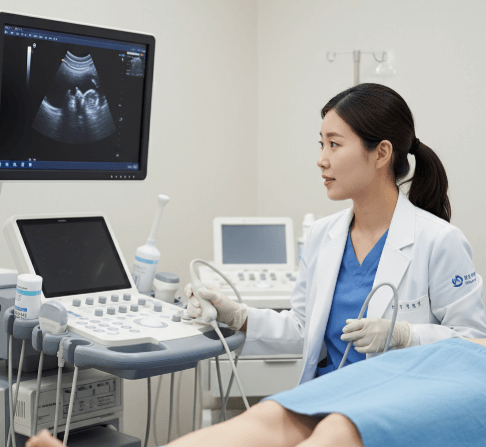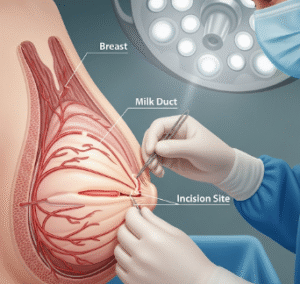What it is
- ➤ A transvaginal ultrasound (TVUS) is an imaging test that uses sound waves to create detailed pictures of a woman’s pelvic organs.
- ✦ A thin ultrasound probe is gently inserted into the vagina to obtain close, high-resolution images of the uterus, endometrium (uterine lining), ovaries, fallopian tubes, and surrounding pelvic structures.
- ➟ Unlike abdominal ultrasound, it provides sharper visualization, especially of small abnormalities.
- Important: TVUS is safe, painless, and radiation-free—it does not involve X-rays.
Why it’s done
- ➤ Primary reasons include:
- ▪ Investigating abnormal uterine bleeding.
- ▪ Evaluating pelvic pain or suspected ovarian cysts/fibroids.
- ▪ Assessing infertility (follicle monitoring, uterine lining evaluation).
- ▪ Detecting early pregnancy or ruling out ectopic pregnancy.
- ▪ Following up on known pelvic conditions (endometriosis, tumors).
- ✦ Benefits:
- ✅ Clearer images of reproductive organs compared to abdominal ultrasound.
- ✅ Helps avoid unnecessary invasive procedures.
- ✅ Widely available in Korea’s clinics and hospitals.
- ⟶ Limitations:
- ▪ Cannot always visualize fallopian tubes unless fluid is present.
- ▪ May not provide full information in women with severe pelvic pain.
- Bold takeaway: TVUS is often the first-line imaging tool in gynecology because of its clarity and accuracy.
Alternatives
- ➤ Abdominal ultrasound: Less invasive but less detailed.
- ✦ MRI: Provides high-resolution images for complex cases but is more expensive.
- ➟ CT scan: Rarely used for gynecology due to radiation exposure.
- Important: TVUS is usually preferred first, with MRI reserved for unclear or advanced cases.
Preparation
- ➤ Before the test:
- ▪ Usually no fasting required.
- ▪ Empty your bladder before the exam (a full bladder is needed for abdominal, but not vaginal ultrasound).
- ✦ Tell your doctor if you:
- ▪ Are pregnant or might be.
- ▪ Have vaginal pain or infections.
- ➟ Clothing: Wear comfortable two-piece outfit for convenience.
- Important: No special preparation is needed, but emotional comfort matters—bring a support person if anxious.
How it’s done
- ➤ Step 1 – Positioning: You lie on the exam table with knees bent.
- ✦ Step 2 – Probe preparation: The transducer is covered with a protective sheath (like a condom) and gel for smooth insertion.
- ➟ Step 3 – Probe insertion: The thin probe (about 2–3 cm wide) is gently placed inside the vagina.
- ➤ Step 4 – Imaging: The doctor/technician moves the probe slightly to capture images of the uterus, ovaries, and pelvic structures.
- ✦ Step 5 – Interpretation: Images are displayed on a monitor and later reviewed by a radiologist or gynecologist.
- → Duration: 10–20 minutes.
- What you feel: Mild pressure, but usually no significant pain.
Recovery
- ➤ Immediately after: You can resume normal activities right away.
- ✦ Possible effects:
- ▪ Very mild spotting (rare).
- ▪ Temporary discomfort if you have pelvic sensitivity.
- ➟ Results:
- ▪ Normal → No structural issues detected.
- ▪ Abnormal → May show fibroids, cysts, polyps, or early pregnancy concerns.
- ⟶ Follow-up depends on results: Sometimes MRI, biopsy, or hysteroscopy may be advised.
- Important: Always schedule a follow-up consultation to discuss the findings in detail.
Treatment option in Korea
- ➤ Where available:
- ▪ All major hospitals and women’s clinics in Seoul, Busan, Incheon, Daegu, and regional centers.
- ▪ Specialized fertility and women’s health centers.
- ✦ Why Korea:
- ▪ Modern high-resolution ultrasound machines.
- ▪ Experienced specialists in gynecology and reproductive medicine.
- ▪ Short waiting times and same-day results.
- ➟ For international patients:
- ▪ Clinics provide multilingual coordinators (English, Chinese, Russian, etc.).
- ▪ Comprehensive packages often include Pap smear, HPV test, ultrasound, and counseling.
- ▪ Written reports in English are available for continuity of care.
- ⟶ If abnormalities are found:
- ▪ Benign findings (cysts, fibroids) → regular monitoring or minor procedures.
- ▪ Precancerous or malignant suspicion → biopsy or surgery.
- ▪ Fertility-related findings → advanced treatments such as IVF can be initiated on-site.
- Important: Korea’s integrated women’s health system allows diagnosis and treatment to be completed efficiently, often within a few days.













